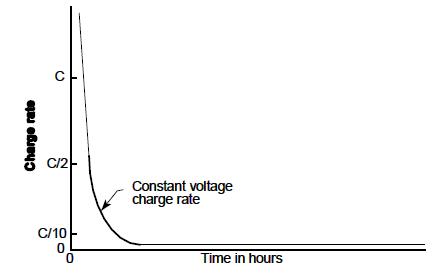Constant Voltage Charging Requirements
Battery Application & Technology
Constant-voltage (often called constant-potential) chargers maintain nearly the same voltage input to the battery throughout the charging process, regardless of the battery's state of charge. Constant-voltage chargers provide a high initial current to the battery because of the greater potential difference between the battery and charger. A constant-voltage charger may return as much as 70% of the previous discharge in the first 30 minutes. This proves useful in many battery applications involving multiple discharge scenarios. As the battery charges its voltage increases quickly. This reduces the potential that has been driving the current, with a corresponding rapid decrease in charge current as depicted in the illustration below. As a result, even though the battery reaches partial charge quickly, obtaining a full charge requires prolonged charging.
Given this behavior, constant-voltage chargers are frequently found in applications that normally allow extended charging periods to attain full charge. Constant-voltage chargers should not be used where there is frequent cycling of the battery. Repeated discharges without returning the cell to its full charge will eventually decrease the battery capacity and may damage individual cells.
Constant-voltage chargers are most often used in two very different modes: as a fast charger to restore a high percentage of charge in a short time or as a float charger to minimize the effects of overcharge on batteries having infrequent discharges.
